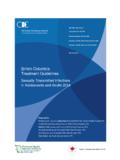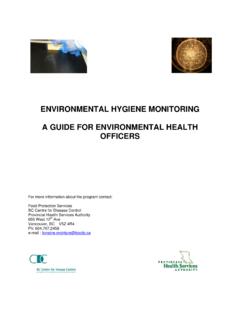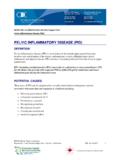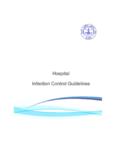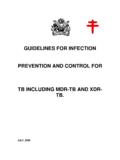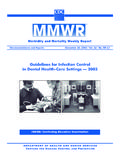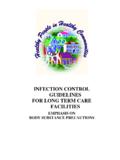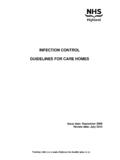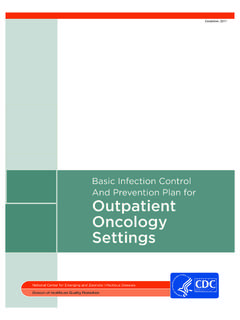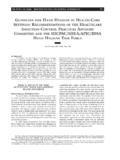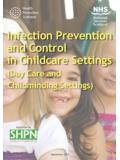Transcription of Gastrointestinal Infection Outbreak Guidelines for ...
1 Gastrointestinal Infection Outbreak Guidelines for Healthcare Facilities Reference Document for use by Health Care Organizations for Internal Policy/Protocol Development British Columbia Provincial Infection Control Network Table of Contents Gastrointestinal Infection Outbreak GUIDELINE WORKING GROUP .. 1 ACRONYMS .. 2 Gastrointestinal Infection Outbreak MANAGEMENT .. 3 INTRODUCTION .. 3 PURPOSE .. 3 LITERATURE SEARCH STRATEGY .. 3 METHODS .. 4 BACKGROUND .. 4 THE Outbreak PREVENTION AND MANAGEMENT TEAM (OPMT) .. 5 ROLES AND RESPONSIBILITIES DURING A Gastrointestinal Infection Outbreak .. 5 British Columbia Centre for Disease Control (BCCDC) Public Health Microbiology & Reference Laboratory .. 5 Environmental Health Officer (EHO) .. 6 Facility Administrator/Manager or Director of Care .. 6 Infection Control Officer (ICO) .. 6 Infection Control Professional (ICP) .. 6 Local Laboratory/ Medical Microbiologist.
2 6 Media/Public Relations .. 6 Medical Director or Facility Individual Physicians .. 6 Medical Health Officer (MHO) .. 6 Health Care Provider (HCP: includes all disciplines who provide direct care) .. 7 Support Services .. 7 Workplace Health and Safety (WH&S)/Occupational Health .. 7 ACTION TABLE .. 8 IDENTIFYING AN Outbreak .. 9 CASE DEFINITION .. 9 POTENTIAL Outbreak /ALERT STAGE .. 9 Outbreak DEFINITION .. 9 REPORTING AND NOTIFICATION .. 9 IDENTIFYING THE SOURCE(S) .. 10 COLLECTION OF SPECIMENS .. 11 Clinical Specimens .. 11 Environmental Samples .. 11 GENERAL PRINCIPLES OF CONTROL .. 12 MODE OF TRANSMISSION FROM PERSON TO PERSON .. 12 ROUTINE PRACTICES .. 12 ADDITIONAL PRECAUTIONS .. 12 RISK ASSESSMENT (13) .. 12 PERSONAL PROTECTIVE EQUIPMENT (9 -12) .. 13 PLACEMENT OF PATIENT/RESIDENT/CLIENT .. 13 LIMITING MOVEMENTS OF PATIENTS/RESIDENTS/CLIENTS .. 13 Patient/Resident/Client Safety .. 13 Acute Care .. 13 Residential Care.
3 14 Common Areas .. 14 RESTRICTIONS OF UNITS .. 14 HCPS EXPOSURE AND ILLNESS .. 15 ONGOING SURVEILLANCE AND REPORTING .. 16 HOUSEKEEPING .. 16 DISINFECTANTS .. 16 CLEANING UP VOMIT AND FECES .. 17 VISITORS AND VOLUNTEERS .. 17 ANIMALS AND PETS .. 17 NOTIFICATION/EDUCATION STRATEGIES .. 17 DECLARING THE Outbreak OVER .. 18 DEBRIEFING THE Outbreak PREVENTION AND MANAGEMENT TEAM .. 18 GLOSSARY .. 19 APPENDIX 1: PUBLIC HEALTH AGENCY OF CANADA, RATING SCALE FOR STRENGTH AND QUALITY OF EVIDENCE .. 22 APPENDIX 2: AGENTS THAT ARE COMMON IN Gastrointestinal Infection OUTBREAKS .. 23 APPENDIX 3: QUICK REFERENCE 26 APPENDIX 4: INITIAL Outbreak REPORT FORM .. 28 APPENDIX 5: Gastrointestinal DISEASE Outbreak KIT ORDER FORM .. 29 APPENDIX 6: BCCDC PUBLIC HEALTH MICROBIOLOGY AND REFERENCE LABORATORY NOTIFICATION FORM .. 30 APPENDIX 7: BCCDC PUBLIC HEALTH AND MICROBIOLOGY REFERENCE LABORATORY GI DISEASE Outbreak REQUISITION FORM .. 31 APPENDIX 8: THE FOUR BASIC ELEMENTS OF ROUTINE PRACTICE.
4 32 APPENDIX 9: GI Outbreak SURVEILLANCE FORM - PATIENTS/RESIDENTS/CLIENTS .. 34 APPENDIX 10: GI Outbreak SURVEILLANCE FORM HCPS .. 35 APPENDIX 11: DISINFECTANTS COMMONLY USED IN GI OUTBREAKS (33, 35, 37, 39, 46, 47) .. 36 APPENDIX 12: CLEANING UP VOMITUS AND FECES .. 38 APPENDIX 13: DAILY UPDATE Outbreak REPORT FOR OPMT .. 39 APPENDIX 14: Outbreak COMMUNICATION MEMO (EXAMPLE) .. 40 APPENDIX 15: SIGN FOR ENTRANCE (EXAMPLE) .. 41 APPENDIX 16: Outbreak SUMMARY REPORT .. 42 REFERENCES .. 43 GI Outbreak Guidelines for Healthcare Facilities June 2010 1 Gastrointestinal Infection Outbreak Guideline Working Group Joanne Archer, , , , CIC Infection Prevention and Control Educator/Consultant, Provincial Infection Control Network Brian Auk Public Health Microbiology and Reference Laboratory British Columbia Center for Disease Control Yin Chang Laboratory Surveillance and Outbreak Coordinator Public Health Microbiology and Reference Laboratory British Columbia Center for Disease Control Ken Cooper Senior Environmental Health Specialist British Columbia Center for Disease Control Fern Davey, , BSN, CIC Infection Control Nurse, Calibre Health Services Terry Dickson, RN Infection Control Practitioner Fraser Health Authority Bev Dobbyn Director, Infection Prevention and Control Vancouver Island Health Authority Bruce Gamage, , BSN, BSc (Micb)
5 , CIC Network Manager, PICNet Debra Giese, CCRN, BSc Infection Control Professional Northern Health Authority Nicki Gill, , BScN, CIC Infection Control Practitioner Interior Health Larry Gustafson, MD, MHSc Medical Health Officer Fraser Health Authority Deanna Hembroff RN, BSN, CIC Acting Manager Infection Prevention and Control Northern Health Authority Marney Hunt, RN, BSN Infection Control Practitioner Children s and Women s Health Center of BC Jessica Ip, BSc, CPHI(C), MBA Senior Environmental Health Officer Vancouver Coastal Health Authority Craig Nowakowski Regional Environmental Health Consultant, Communicable Disease Vancouver Island Health Authority Marsha Taylor Epidemiologist British Columbia Center for Disease Control Cathy Smith, OHN, BSN, COHN (C) Program Leader Health and Wellness, Workplace Health Fraser Health Greg Tone, CPHI (C) Environmental Health Officer Northern Health Authority Julie Wong Public Health Microbiology and Reference Laboratory British Columbia Center for Disease Control GI Outbreak Guidelines for Healthcare Facilities June 2010 2 Acronyms ABHR - Alcohol based hand rub BCCDC - British Columbia Centre for Disease Control EHO - Environmental Health Officer GI Gastrointestinal HCP Health Care Provider ICO Infection Control Officer ICP - Infection Control Professional LPN Licensed Practical Nurse LO Community Care Licensing Officer MHO Medical Health Officer OHN Occupational Health Nurse OPMT Outbreak Prevention and Management Team PCRA Point of Care Risk Assessment PIDAC Provincial Infectious Disease Advisory Committee.
6 Ontario PPE Personal Protective Equipment RN Registered Nurse WH&S Workplace Health and Safety GI Outbreak Guidelines for Healthcare Facilities June 2010 3 Gastrointestinal Infection Outbreak Management Introduction Gastrointestinal (GI) infections may be caused by a variety of agents including bacteria, viruses and protozoa. Healthcare associated transmission of GI infections usually results from contact with infected individuals, from consumption of food, water, or other beverages, or from exposure to contaminated objects or environmental surfaces (1). Outbreaks of GI infections can be devastating and lead to significant increased costs, increased patient morbidity, and in some instances patient mortality. Henson et al. (2) gave the mean estimate of the overall economic burden of GI infections to be 514 million dollars per year in British Columbia. The most important characteristic of pathogens responsible for infectious GI infections is their ability to be rapidly transmitted in healthcare settings among individuals who often are highly susceptible.
7 Episodes of infectious GI infections account for a significant proportion of all patients/residents/clients in healthcare settings who develop diarrhea with or without nausea and/or vomiting. Purpose This reference document is intended to provide information and guidance for all healthcare facilities when developing or updating their policies and processes that pertain to prevention, surveillance for, identification and control of GI Infection outbreaks. This document was not developed to address an Outbreak cause by , although many of the same principles still apply. Please consult literature written specifically for this organism such as Control of Clostridium Difficile infections (CDI) Outbreaks in Hospitals by PIDAC. This document will enable policy or protocol development to be more straightforward, timely and require less resources. Effective Outbreak management requires a collaborative effort between Public Health, Infection Prevention and Control, Laboratory Services, Workplace Health and Safety, facility Managers and facility HCPs.
8 Literature Search Strategy Electronic searches of Medline, Science Direct, PubMed, Google Scholar and Cinahl (January 2004 -November 2009) were carried out to identify relevant papers. For key questions where insufficient evidence was found the literature search date was extended to 1995. Search terms used were: rotavirus, calicivirus, norovirus, Salmonella, Escherichia coli, adenovirus, or infections caused by these agents, Gastrointestinal diseases, communicable diseases, disease outbreaks, virus shedding, Infection control, alcohol, anti-infective agents, immunity after Infection , hospital food service, kitchen, cooking utensils, eating utensils, animals and pets. References cited in eligible papers that were considered to be relevant were also obtained. Of those titles identified 436 abstracts were reviewed and 139 full articles were read. GI Outbreak Guidelines for Healthcare Facilities June 2010 4 Methods The recommendations made within this guideline are graded based on the level of supporting evidence available, using the Public Health Agency of Canada rating scale for strength and quality of evidence ( Appendix 1).
9 The grading level assigned does not relate to the importance of the recommendation, but to the strength of the supporting evidence. Evidence tables were created by the writer where moderate to strong evidence to support the recommendations was available. These tables were reviewed by the Guideline Working Group (GWG). For recommendations based on the expert opinion of the GWG members, any differences in opinion were resolved through discussion and consensus. This process was reviewed and approved by the Guidelines Steering Committee. Background Often pathogenic organisms do not cause GI infections because of the protective mechanisms of the GI tract. Under normal circumstances organisms are unable to establish themselves in quantities sufficient to cause illness because they are carried straight down the GI tract and excreted with the rest of the intestinal contents. Also the presence of mucus protects the epithelial cells that line the GI tract, perhaps acting as a mechanical barrier by blocking attachment to the epithelial cells.
10 The mucus also contains IgA antibodies which help protect an individual when their immune system is healthy (3). Specific attributes have been developed by some organisms that enable them to overcome the body s natural defenses. These include: (4) Specific attachment to intestinal epithelium which enables them to avoid expulsion and establish themselves. Motility, which enables them to travel through mucus allowing the pathogen to reach susceptible cells. Production of mucinase, an enzyme that assists the transit through any mucus that is present. Resistance to stomach acids which allows them to reproduce in large numbers in the stomach and produce Infection and shedding from the GI tract. Resistance to bile and proteolytic enzymes which allows them to reproduce in large numbers in the GI tract. When the infecting microorganism penetrates the intestinal epithelium the severity of the illness that it is able to produce depends upon: (3) It s ability to multiply in large numbers and spread throughout the GI tract, The production of toxins, The degree of cell damage it is able to cause and The individuals inflammatory and immune responses.

